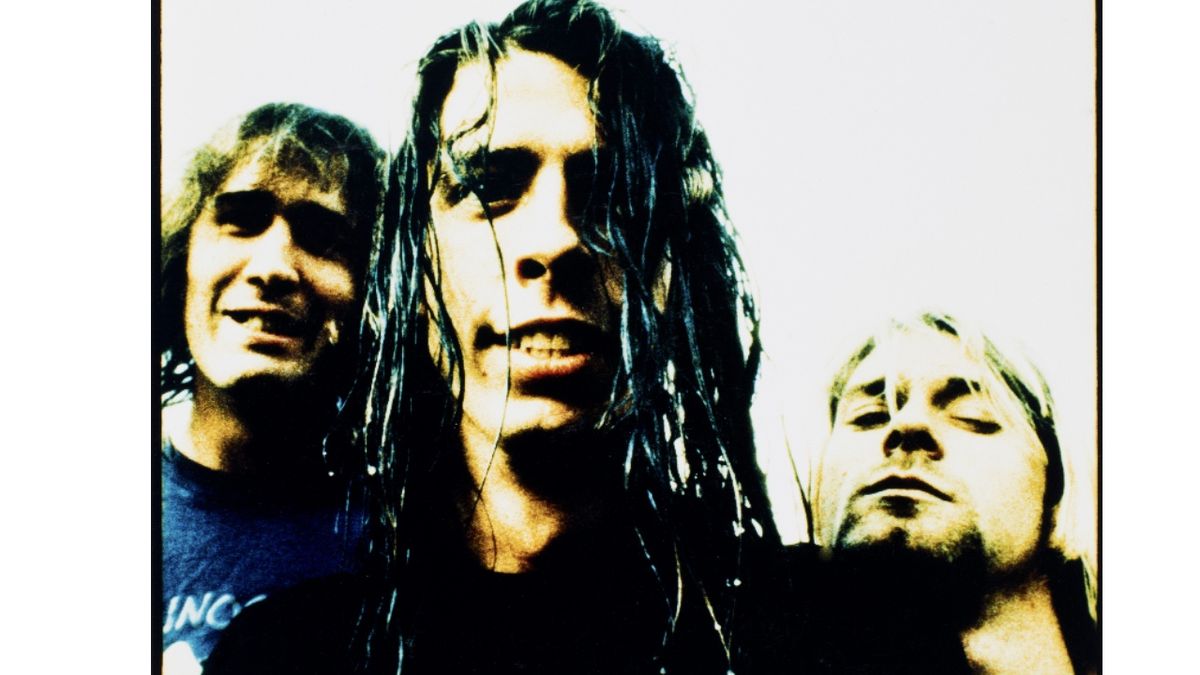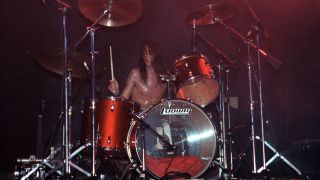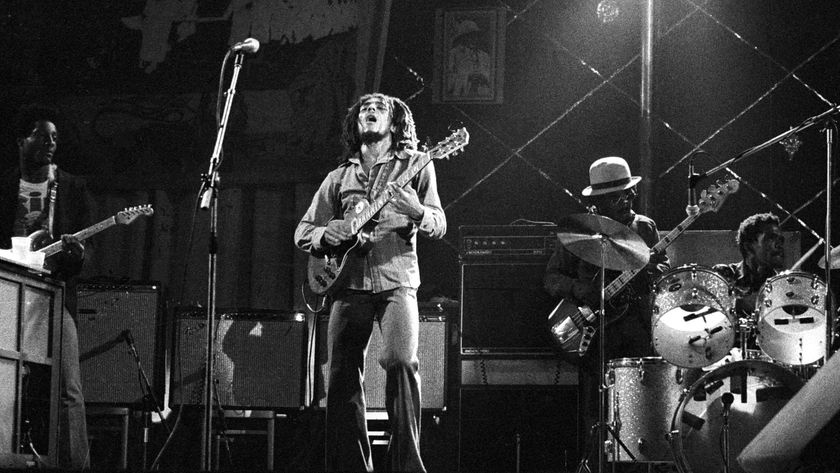20 drum facts about Nirvana's Nevermind you might not know
Inside the making of the album that launched Dave Grohl

Just over three decades ago, Nirvana unleashed Nevermind into the world, bringing with it Dave Grohl’s indelible imprint on the world of rock drumming. We’ll forego the full backstory of how nobody expected Nevermind to be a hit, or how Nirvana wiped out an army of hair metal bands overnight, and do we really need to remind you of how Nevermind de-throned the invincible King Of Pop, Michael Jackson from the top of the Billboard chart?
You know the music, you’ve probably learned the drum parts, and for sure you know about the tragic, shortened lifespan of the band. but here are 20 facts based around the drumming on one of the most important rock albums of all time.
1. Hired Drums
Producer, Butch Vig enlisted the help of famed tech Ross Garfield, AKA The Drum Doctor (and owner of Drum Doctors rentals) when it came to getting the drum sound on Nevermind.
Jim Berkenstadt and Charles Cross’ book Classic Rock Albums: Nirvana, Nevermind, features a copy of the Drum Doctors’ rental invoice, which lists two 14”x6.5” snare drums, a bass drum tunnel, 2 unspecified cymbals, a DW 5000 Turbo pedal one case of drum sticks, a 15” Gauger RIMS mount, 15”, 18” and 14” drum heads and one ‘bag’. The total cost of the hire was $1542, and the gear was rented for 10 days between 2-11 May, 1991.
2. The kit
Sometimes reported as a Tama Artstar II kit, very few photos exist of the drums used in the Nevermind sessions. However, from the ones that do, you can see that the toms and bass drum feature split lugs, as-per the mid-80s Tama Granstar. The Nevermind shells were also finished in Tama’s Granstar Silky Yellow plastic wrap.
Nirvana wasn’t Grohl’s first rodeo. Previously playing with DC punk legends, Scream, the photo above (posted to the band’s Facebook account) suggests that he already owned the Tama shells before joining Nirvana, which also puts an end to the question of whether or not he rented the shells from Drum Doctors.
3. The kit was as simple as the drumming

In the era where racks and double-figure kit pieces accompanied by cymbals at every turn was the norm, Grohl kept his setup as simple as the parts he played on it. The entire setup for Nevermind closely mirrored Grohl's preffered live setup, featuring a four-piece kit with two crashes, a ride and a pair of hi-hats.
Get the MusicRadar Newsletter
Want all the hottest music and gear news, reviews, deals, features and more, direct to your inbox? Sign up here.
The shell sizes were an homage to Grohl’s hero, John Bonham, with a 24”x16” bass drum, huge 15”x12” rack tom and 18”x16” floor tom (as-per the heads supplied by Drum Doctors).
4. You had an opportunity to buy a piece of it
Grohl continued to play the Nevermind kit after the recording sessions, but it didn’t take long before they met the same fate as countless others would over the next three years during the climax of Nirvana’s live sets.
The Granstar was smashed on stage at the Caberet Metro, Chicago, 12 October 1991: the same day Nevermind entered the Billboard 100 at no.144. Christies auctioned a remnant of the rack tom in 2011 with an estimate of £3000-£5000. It actually sold for £8125.
5. The 'Terminator'
Tama’s cast Bell Brass forms the backbone of much of Nevermind’s sound - according to Butch Vig it was used on all but one song, most likely Something In The Way.
The Bell Brass was part of the rental haul from Drum Doctors, and this drum in particular is one of six owned by Garfield. It was nicknamed The Terminator owing to its loud, heavy sound. “For some reason, this drum sounds better than any of the other Tama Bell Brass drums that I’ve ever heard — and I’ve got six others!” Garfield told Drum! Magazine. “They all have the crack, but this one has the low end. It weighs about 30 lbs., which was unheard of when that drum was originally made.”
The early 90s helped make the Tama Bell Brass a modern-day classic thanks to appearances on Metallica’s Black Album, Stone Temple Pilots’ Core, The Offspring’s Smash and many more. A year after nirvana recorded Nevermind at Sound City, Rage Against The Machine entered the same studio, and Brad Wilk was armed with the same drum.
6. Nevermind could have turned out very differently
Nevermind, the follow-up to Nirvana’s Sub-Pop debut was originally due to be recorded at Butch Vig’s Smart Studios in Madison, Wisconsin. In fact, the band - at that time still featuring previous drummer, Chad Channing - actually began tracking the album there in April 1990 with the intention of releasing it on the indie label.
However, due to Channing’s exit from the band and - following rumours Sub-Pop was seeking a deal with a major label - Nirvana regrouped with Grohl in-tow, and instead pursued a major label record deal without Sub-Pop in the middle. If the original scenario had played out, the album may never have found a platform as high as it did.
7. Dave Grohl isn’t the only drummer on the album
There’s no denying that Grohl’s hard-hitting approach not only bolsters Nevermind’s sound, but helped cement his place as one of rock’s all-time great drummers. But Chad Channing’s input to Nevermind shouldn’t be overlooked either (see the next point).
After tracking at Sound City, Nirvana kept the original Smart Sessions recording of Polly on the final album release, which featured uncredited cymbal crashes played by Chad. It’s a small part, but he’s on there.
8. Chad Channing wrote some the drum parts
The Smart Sessions have been available via bootleg and official releases for many years, and serve as testament to Chad Channing’s input on the album. The band recorded eight songs with Vig at Smart Studios: In Bloom, Lithium, Immodium (appearing as Breed on Nevermind), Pay To Play (renamed Stay Away), and of course, Polly, with Grohl adopting the core parts for the final versions.
Grohl paid tribute to Channing’s input during his Rock and Roll Hall of Fame acceptance speech when nirvana was inducted in 2014. “Here’s the thing. Guess what Chad’s responsible for? If you listen to a song like In Bloom, that’s Chad.
"When I joined the band, I had the honour of playing Chad’s parts, so Chad, thank you very much for allowing me to play your drum parts.”
9. Smashing drum things
Nirvana started the final album sessions with Butch Vig at Sound City the same month that Smashing Pumpkins’ Vig-produced Gish was released. However Nirvana actually entered the studio at Smart with Vig before the Pumpkins began work on their album, and both Gish and the Smart Sessions make use of Butch Vig’s own Yamaha snare drum.
The Law of The Sod determines that Channing doesn’t hit the snare on his Nevermind contribution, and the tuning on Gish is quite different, but you can compare the two recordings from the Nevermind outtake songs.
10. Sound City was chosen for its drum sound
When Nirvana signed to Geffen, they were still relatively unknown. That meant that while the Nevermind recording budget was literally 100-times more than the $600 spent recording Bleach, it was still small by early 90s standards.
So, as well as the fact it was affordable, Vig opted for Sound City based on its reputation for having a great live room when it came to recording drums. Indeed, it was a known favourite room of Jeff Porcaro - no stranger to big-budget drum sounds and had previously created a string of huge-selling albums including Fleetwood Mac's Rumours
11. Grohl owns the Neve Nevermind was recorded through
Famously, Dave Grohl devised, directed and produced the Sound City documentary in 2013 in order to pay tribute to the studio that helped launch his career. As well as the studio itself, though, the catalyst for the film was the Neve 2028 desk that had resided there for decades. Grohl detailed his purchase of the console, which is now housed in Grohl/Foo Fighters Studio 606 and is available for use commercially.
12. Andy Wallace's samples
While Sound City’s reputation for having a stellar live room can’t be denied, famed mix engineer Andy Wallace was called in for Nevermind’s final versions and interviews given in the subsequent years fuelled rumours that he sample-replaced some of the recorded drum sounds. The truth is somewhere in between.
In 1991, sample replacement was a more difficult and crude process than it is today. Wanting greater control over the ambience, without muddying the sound with hi-hat and cymbal was, Wallace triggered custom samples into a reverb unit from the drums, resulting in a bigger room sound where he wanted it, without the mess of bled room sounds. So, Nevermind does contain drum samples, but only in the ambient part of the drum sounds.
13. Butch Vig’s mixes are available to compare
Butch Vig originally created mixes that were submitted to Geffen, however Wallace was brought in to spruce-up the overall sounds. Vig’s mixes (sans Wallace’s ambience samples) were made available on the 20th Anniversary Super Deluxe release of Nevermind, labelled as the Devonshire mixes, and give us the opportunity to hear the difference between the two.
14. The Bass drum tunnel
While these days there are commercially-available bass drum extenders, the solution Butch Vig hired-in for recording Nevermind was a lot more straightforward. The ‘extender’ was in-fact a laminated bass drum case with the ends cut out to form an open tube.
It was placed in front of the bass drum with towels covering the seam, allowing for a farther mic-position on the bass drum while eliminating some of the bleed from the rest of the kit and room, and the distance arguably increasing the bass content too.
15. There’s no magic in the mic’ing
Given that Nevermind’s drum sound ranks among some of the greatest in at least the modern era of rock music, you’d be forgiven for thinking that there was some sort of magic going on.
However, the secret lies in a great drummer, in a great room, captured by classic microphones and a brilliant engineer/producer. “It was a pretty simple setup.” Vig told us in 2020.
“I told the engineer that I wanted to default to mics I knew and was used to, so I used an AKG D12 on the kick, I think I used an SM57 on the snare and possible AKG 451 underneath. We used Sennheiser 421s on the toms, again because I was used to those Sennheiser mics. AKG 414s as the overheads, I had them at Smart and they’re great all-round condensers.
"I think the secret to that sound, is we had a couple of Neumann U87s that were probably 15-18 feet back from the kit. That room at Sound City, it’s like a small gymnasium and it’s almost bulletproof, as soon you put the mics up on the Neve it all sounds good.
"But when you put up those room mics and hear the sound of that room, that’s part of what made that studio sound so good. It just had a really awesome tone to it. It was live, but not too splashy, the decay time on the high end of the midrange is very even. It’s the perfect room for drums, really. It also helped that Dave Grohl, one of the most kick-ass drummers in rock and roll was behind the kit!”
16. Smells Like Teen Spirit owes disco
Talk about Nevermind’s drums, and you have to talk about the snare drum flams that usher in the band on Smells Like Teen Spirit. But Dave Grohl recently made revelation to hitmaker, Pharrell Williams that he owes it all to disco.
“If you listen to ‘Nevermind’, the Nirvana record, I pulled so much stuff from The Gap Band and Cameo and Tony Thompson on every one of those songs. All that [tapping flams on his knees]. It’s all disco, that’s all it is. Nobody makes the connection.”
17. Simplicity was key
At the heart of Nirvana’s music were great songs, and while the presentation is more complex, the simplicity of the instrumental tracks, particularly the drum parts was entirely deliberate.
During a time where technical ability and showmanship were key ingredients of rock music, Nirvana’s straightforward loud/quiet approach not only reflected the band’s punk ethos, but helped convey the songs and stand out.
Grohl addressed this during the Classic Albums documentary on Nevermind, “I didn’t throw a bunch of drum fills in there. I tried to keep it as simple as possible. That was kind of an unspoken rule. We almost wanted them to be like children’s songs. We’d tell people that the songs were intended to be as simple as possible”.
18. Grohl struggled to play quietly
You only have to watch Dave Grohl play to realise just how hard he hits the drums, a trait that added the necessary power and punch to Nirvana upon his arrival. However, during the recording of Something In The Way - which saw the bass and drums overdubbed to Kurt Cobain’s free-time guitar take - his heavy-handed approach made it difficult to achieve the sound Cobain was looking for.
Butch Vig remembered on Classic Albums, “We went back and overdubbed. It was very difficult for both Krist and Dave to do the drums and bass because with no click track, the timing was kind of all over the place. I think I tortured them on it, at some points we punched bar by bar…”
“While Dave was doing the drums, Kurt was in the back of the control room saying ‘Quieter, quieter, quieter!’ I think it’s in his nature to hit hard, but he played it very mellow, very understated. They recorded it in Studio B at Sound City which is a dead dry room compared to the live room.”
19. Nevermind was the first time Grohl used a click
One of the stand-out singles contained on Nevermind is Lithium, and the drum track was actually one of the only songs where the band tracked to a click. “First of all, they kept speeding the song up. It was one of the few tracks we used a click track to. Dave was great, he’d never really worked with a click, but he was fine as soon as he did it a couple of times.”
Having been problematic during the Smart Sessions - with Cobain apparently encouraging Channing to play the drum part he’d imagined for the song - this time was no easier.
Cobain’s frustration at recording his guitar parts for Lithium resulted in him abandoning the song, instead instigating one of the band’s regular jams before smashing his guitar. Vig captured the chaos, and the song became Endless Nameless, Nevermind’s secret track that appears 10 minutes after the end of Something In The Way.
20. Grohl's Nevermind Sappy is still unreleased
Sappy is a recurring song in the Nirvana canon which was recorded in multiple guises, from Cobain’s home demos through to full-band versions. Chad Channing tracked two studio versions of the song, as did Grohl.
Arguably closest to Nevermind stylistically, the first official release of Sappy was actually captured by Steve Albini during the In Utero sessions and featured Grohl on drums, with two of the other studio versions having been officially released since.
The only remaining unheard version of Sappy is the band’s attempt during the Nevermind sessions at Sound City, but with the newly-announced 30th anniversary edition of Nevermind due in November boasting 70 unreleased tracks, now might be the time!

I'm a freelance member of the MusicRadar team, specialising in drum news, interviews and reviews. I formerly edited Rhythm and Total Guitar here in the UK and have been playing drums for more than 25 years (my arms are very tired). When I'm not working on the site, I can be found on my electronic kit at home, or gigging and depping in function bands and the odd original project.

"Reggae is more freeform than the blues. But more important, reggae is for everyone": Bob Marley and the Wailers' Catch a Fire, track-by-track

“Part of a beautiful American tradition”: A music theory expert explains the country roots of Beyoncé’s Texas Hold ‘Em, and why it also owes a debt to the blues










